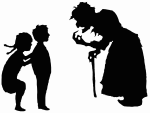Hansel and Gretel
| Hansel and Gretel | |
|---|---|
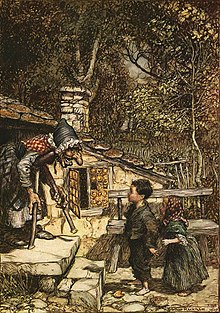 The witch welcomes Hansel and Gretel into her hut. Illustration by Arthur Rackham, 1909. | |
| Folk tale | |
| Name | Hansel and Gretel |
| Data | |
| Aarne–Thompson grouping | ATU 327A |
| Region | German |
| Published in | Kinder- und Hausmärchen, by the Brothers Grimm |
"Hansel and Gretel" (/ˈhænsəl, ˈhɛn- ... ˈɡrɛtəl/; also known as Hansel and Grettel, or Little Brother and Little Sister; German: Hänsel und Gret(h)el [ˈhɛnzl̩ ʔʊnt ˈɡʁeːtl̩])[a] is a German fairy tale collected by the Brothers Grimm and published in 1812 in Grimm's Fairy Tales (KHM 15).[1][2]
Hansel and Gretel are a brother and sister abandoned in a forest, where they fall into the hands of a witch who lives in a house made of gingerbread, cake, and pastries. The cannibalistic witch intends to fatten the children before eventually eating them, but Gretel outwits the witch and kills her. The two children then escape with their lives and return home with the witch's treasure.[3]
"Hansel and Gretel" is a tale of Aarne–Thompson–Uther type 327A.[4][5] It also includes an episode of type 1121 ('Burning the Witch in Her Own Oven').[6][2] The tale has been adapted to various media, most notably the opera Hänsel und Gretel (1893) by Engelbert Humperdinck.[7][8]
Origin[]
Sources[]
Although Jacob and Wilhelm Grimm credited "various tales from Hesse" (the region where they lived) as their source, scholars have argued that the brothers heard the story in 1809 from the family of Wilhelm's friend and future wife, Dortchen Wild, and partly from other sources.[9] A handwritten note in the Grimms' personal copy of the first edition reveals that in 1813 Wild contributed to the children's verse answer to the witch, "The wind, the wind,/ The heavenly child," which rhymes in German: "Der Wind, der Wind,/ Das himmlische Kind."[2]
According to folklorist Jack Zipes, the tale emerged in the Late Middle Ages (1250–1500). Shortly after this period, close written variants like Martin Montanus' Gartengesellschaft (1590) began to appear.[3] Scholar Christine Goldberg argues that the episode of the paths marked with stones and crumbs, already found in the French "Finette Cendron" and "Hop-o'-My-Thumb" (1697), represents "an elaboration of the motif of the thread that Ariadne gives Theseus to use to get out of the Minoan labyrinth".[10] A house made of confectionery is also found in a 14th-century manuscript about the Land of Cockayne.[7]
Editions[]
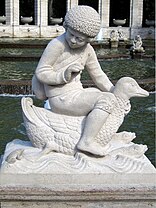
From the pre-publication manuscript of 1810 (Das Brüderchen und das Schwesterchen) to the sixth edition of Kinder- und Hausmärchen (Grimm's Fairy Tales) in 1850, the Brothers Grimm made several alterations to the story, which progressively gained in length, psychological motivation, and visual imagery,[11] but also became more Christian in tone, shifting the blame for abandonment from a mother to a stepmother associated with the witch.[1][3]
In the original edition of the tale, the woodcutter's wife is the children's biological mother,[12] but she was also called "stepmother" from the 4th edition (1840).[13][5] The Brothers Grimm indeed introduced the word "stepmother", but retained "mother" in some passages. Even their final version in the 7th edition (1857) remains unclear about her role, for it refers to the woodcutter's wife twice as "the mother" and once as "the stepmother".[2]
The sequence where the duck helps them across the river is also a later addition. In some later versions, the mother died from unknown causes, left the family, or remained with the husband at the end of the story.[14] In the 1810 pre-publication manuscript, the children were called "Little Brother" and "Little Sister", then named Hänsel and Gretel in the first edition (1812).[11] Wilhelm Grimm also adulterated the text with Alsatian dialects, "re-appropriated" from 's Alsatian version (1842) in order to give the tale a more "folksy" tone.[5][b]
Goldberg notes that although "there is no doubt that the Grimms' Hänsel und Gretel was pieced together, it was, however, pieced together from traditional elements," and its previous narrators themselves had been "piecing this little tale together with other traditional motifs for centuries."[6] For instance, the duck helping the children cross the river may be the remnant of an old traditional motif in the folktale complex that was reintroduced by the Grimms in later editions.[6]
Plot[]

The story is set in medieval Germany. Hansel and Gretel are the young children of a poor woodcutter. When a great famine settles over the land, the woodcutter's second wife decides to take the children into the woods and leave them there to fend for themselves, so that she and her husband do not starve to death, as the children eat too much. The woodcutter opposes the plan but his wife claims that maybe a stranger will take the children in and provide for them, which the woodcutter and she simply cannot do. With the scheme seemingly justified, the woodcutter reluctantly is forced to submit to it. They are unaware that in the children's bedroom, Hansel and Gretel have overheard them. After the parents have gone to bed, Hansel sneaks out of the house and gathers as many white pebbles as he can, then returns to his room, reassuring Gretel that God will not forsake them.
The next day, the family walk deep into the woods and Hansel lays a trail of white pebbles. After their parents abandon them, the children wait for the moon to rise and then they followed the pebbles back home. They return home safely, much to their stepmother's rage. Once again provisions become scarce and the mother angrily orders her husband to take the children further into the woods and leave them there to die. Hansel and Gretel attempt to gather more pebbles, but find the doors locked and find it impossible to escape.
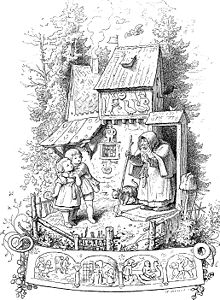
The following morning, the family treks into the woods. Hansel takes a slice of bread and leaves a trail of bread crumbs for them to follow home. However, after they are once again abandoned, they find that the birds have eaten the crumbs and they are lost in the woods. After days of wandering, they follow a beautiful white bird to a clearing in the woods, and discover a large cottage built of gingerbread, cookies, cakes, candy, chocolate, jellies and with window panes of clear sugar. Hungry and tired, the children begin to eat the rooftop of the house, when the door opens and a "very old woman" emerges and lures the children inside with the promise of soft beds and delicious food. They enter without realizing that their hostess is a bloodthirsty witch who built the gingerbread house to waylay children to cook and eat them.
The next morning, the witch locks Hansel in an iron cage in the garden and forces Gretel into becoming a slave. The witch feeds Hansel regularly to fatten him up, but serves Gretel nothing but crab shells. The witch then tries to touch Hansel's finger to see how fat he has become, but Hansel cleverly offers a thin bone he found in the cage. As the witch's eyes are too weak to notice the deception, she is fooled into thinking Hansel is still too thin to eat. After weeks of this, the witch grows impatient and decides to eat Hansel, "be he fat or lean".
She prepares the oven for Hansel, but decides she is hungry enough to eat Gretel, too. She coaxes Gretel to the open oven and asks her to lean over in front of it to see if the fire is hot enough. Gretel, sensing the witch's intent, pretends she does not understand what the witch means. Infuriated, the witch demonstrates, and Gretel instantly shoves the witch into the hot oven, slams and bolts the door shut, and leaves "The ungodly witch to be burned in ashes". Gretel frees Hansel from the cage and the pair discover a vase full of treasure, including precious stones. Putting the jewels into their clothing, the children set off for home. A swan ferries them across an expanse of water, and at home they find only their father; his wife died from some unknown cause. Their father had spent all his days lamenting the loss of his children, and is delighted to see them safe and sound. With the witch's wealth, they all live happily ever after.
Variants[]
Folklorists Iona and Peter Opie indicate that "Hansel and Gretel" belongs to a group of European tales especially popular in the Baltic regions, about children outwitting ogres into whose hands they have involuntarily fallen.[7]
ATU 327A tales[]
"Hansel and Gretel" is the prototype for the fairy tales of the type Aarne–Thompson–Uther (ATU) 327A. In particular, Gretel's pretense of not understanding how to test the oven ("Show Me How") is characteristic of 327A, although it also appears traditionally in other sub-types of ATU 327.[15] As argued by Stith Thompson, the simplicity of the tale may explain its spread into several traditions all over the world.[16]
A closely similar version is "Finette Cendron", published by Marie-Catherine d’Aulnoy in 1697, which depicts an impoverished king and queen deliberately losing their three daughters three times in the wilderness. The cleverest of the girls, Finette, initially manages to bring them home with a trail of thread, then a trail of ashes, but her peas are eaten by pigeons during the third journey. The little girls then go to the mansion of a hag, who lives with her husband the ogre. Finette heats the oven and asks the ogre to test it with his tongue, so that he falls in and is incinerated. Thereafter, Finette cuts off the hag's head. The sisters remain in the ogre's house, and the rest of the tale relates the story of "Cinderella".[7][10]
In the Russian Vasilisa the Beautiful, the stepmother likewise sends her hated stepdaughter into the forest to borrow a light from her sister, who turns out to be Baba Yaga, a cannibalistic witch. Besides highlighting the endangerment of children (as well as their own cleverness), the tales have in common a preoccupation with eating and with hurting children: The mother or stepmother wants to avoid hunger, and the witch lures children to eat her house of candy so that she can then eat them.[17]
In a variant from Flanders, The Sugar-Candy House, siblings Jan and Jannette get lost in the woods and sight a hut made of confectionary in the distance. When they approach, a giant wolf named Garon jumps out of the window and chases them to a river bank. Sister and brother ask a pair of ducks to help them cross the river and escape the wolf. Garon threatened the ducks to carry him over, to no avail; he then tries to cross by swimming. He sinks and surfaces three times, but disappears in the water in the fourth try. The story seems to contain the "child/wind" rhyming scheme of the German tale.[18]
In a Swedish fairy tale, La Cabane au Toit de Fromage ("The Hut with the Roof made of Cheese"), the brother is the hero who deceives the witch and locks her up in the oven.[19]
Other folk tales of ATU 327A type include the French "The Lost Children", published by Antoinette Bon in 1887,[20][21] or the Moravian "Old Grule", edited by Maria Kosch in 1899.[21]
The Children and the Ogre (ATU 327)[]
Structural comparisons can also be made with other tales of ATU 327 type ("The Children and the Ogre"), which is not a simple fairy tale type but rather a "folktale complex with interconnected subdivisions" depicting a child (or children) falling under the power of an ogre, then escaping by their clever tricks.[22]
In ATU 327B ("The Brothers and the Ogre"), a group of siblings come to an ogre's house who intends to kill them in their beds, but the youngest of the children exchange the visitors with the ogre's offspring, and the villain kills his own children by mistake. They are chased by the ogre, but the siblings eventually manage to come back home safely.[23] Stith Thompson points the great similarity of the tales types ATU 327A and ATU 327B that "it is quite impossible to disentangle the two tales".[24]
ATU 327C ("The Devil [Witch] Carries the Hero Home in a Sack") depicts a witch or an ogre catching a boy in a sack. As the villain's daughter is preparing to kill him, the boy asks her to show him how he should arrange himself; when she does so, he kills her. Later on, he kills the witch and goes back home with her treasure. In ATU 327D ("The Kiddlekaddlekar"), children are discovered by an ogre in his house. He intends to hang them, but the girl pretends not to understand how to do it, so the ogre hangs himself to show her. He promises his kiddlekaddlekar (a magic cart) and treasure in exchange of his liberation; they set him free, but the ogre chases them. The children eventually manage to kill him and escape safely. In ATU 327F ("The Witch and the Fisher Boy"), a witch lures a boy and catches him. When the witch's daughter tries to bake the child, he pushes her into the oven. The witch then returns home and eats her own daughter. She eventually tries to fell the tree in which the boy is hiding, but birds fly away with him.[23]
Further comparisons[]
The initial episode, which depicts children deliberately lost in the forest by their unloving parents, can be compared with many previous stories: Montanus's "The Little Earth-Cow" (1557), Basile's "Ninnillo and Nennella" (1635), Madame d'Aulnoy's "Finette Cendron" (1697), or Perrault's "Hop-o'-My-Thumb" (1697). The motif of the trail that fails to lead the protagonists back home is also common to "Ninnillo and Nennella", "Finette Cendron" and "Hop-o'-My-Thumb",[25] and the Brothers Grimm identified the latter as a parallel story.[26]
Finally, ATU 327 tales share a similar structure with ATU 313 ("Sweetheart Roland", "The Foundling", "Okerlo") in that one or more protagonists (specifically children in ATU 327) come into the domain of a malevolent supernatural figure and escape from it.[23] Folklorist Joseph Jacobs, commenting on his reconstructed proto-form of the tale (Johnnie and Grizzle), noticed the "contamination" of the tale with the story of The Master Maid, later classified as ATU 313.[27] ATU 327A tales are also often combined with stories of ATU 450 ("Little Brother and Sister"), in which children run away from an abusive stepmother.[3]
Analysis[]
According to folklorist Jack Zipes, the tale celebrates the symbolic order of the patriarchal home, seen as a haven protected from the dangerous characters that threaten the lives of children outside, while it systematically denigrates the adult female characters, which are seemingly intertwined between each other.[8][28] The mother or stepmother indeed dies just after the children kill the witch, suggesting that they may metaphorically be the same woman.[29] Zipes also argues that the importance of the tale in the European oral and literary tradition may be explained by the theme of child abandonment and abuse. Due to famines and lack of birth control, it was common in medieval Europe to abandon unwanted children in front of churches or in the forest. The death of the mother during childbirth sometimes led to tensions after remarriage, and Zipes proposes that it may have played a role in the emergence of the motif of the hostile stepmother.[28]
Linguist and folklorist Edward Vajda has proposed that these stories represent the remnant of a coming-of-age, rite-of-passage tale extant in Proto-Indo-European society.[30][31] Psychologist Bruno Bettelheim argues that the main motif is about dependence, oral greed, and destructive desires that children must learn to overcome, after they arrive home "purged of their oral fixations". Others have stressed the satisfying psychological effects of the children vanquishing the witch or realizing the death of their wicked stepmother.[8]
Cultural legacy[]
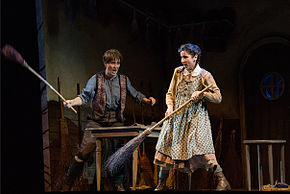
Stage and musical theater[]
The fairy tale enjoyed a multitude of adaptations for the stage, among them the opera Hänsel und Gretel by Engelbert Humperdinck—one of the most performed operas.[32] It is principally based upon the Grimm's version, although it omits the deliberate abandonment of the children.[7][8]
A contemporary reimagining of the story, Mátti Kovler's musical fairytale Ami & Tami, was produced in Israel and the United States and subsequently released as a symphonic album.[33][34]
Literature[]
Several writers have drawn inspiration from the tale, such as Robert Coover in "The Gingerbread House" (Pricks and Descants, 1970), Anne Sexton in Transformations (1971), Garrison Keillor in "My Stepmother, Myself" in "Happy to Be Here" (1982), and Emma Donoghue in "A Tale of the Cottage" (Kissing the Witch, 1997).[8]
Film[]
- A production by Shelly Duvall was aired in 1982 starring Ricky Schroder as Hansel and Joan Collins as the stepmother/witch.
- Hansel and Gretel, a 1983 tv special directed by Tim Burton.
- Elements from the story were used in the 1994 horror film Wes Craven's New Nightmare for its climax.
- "Hänsel und Gretel"[35] by 2012 German Broadcaster RBB released as part of its series Der rbb macht Familienzeit.
- Hansel & Gretel: Witch Hunters (2013) by Tommy Wirkola with Jeremy Renner and Gemma Arterton, (USA, Germany). The film follows the adventures of Hansel & Gretel who became adults.
- Gretel & Hansel, a 2020 American horror film directed by Oz Perkins.
- Secret Magic Control Agency (2021) is an animated retelling of the fairy tale by incorporating comedy and family genres[36]
Computer programming[]
Hansel and Gretel's trail of breadcrumbs inspired the name of the navigation element "breadcrumbs" that allows users to keep track of their locations within programs or documents.[37]
Video games[]
- Hansel & Gretel and the Enchanted Castle (1995) by Terraglyph Interactive Studios is an adventure and hidden object game. The player controls Hansel, tasked with finding Prin, a forest imp, who holds the key to saving Gretel from the witch.[38]
- Gretel and Hansel (2009) by Mako Pudding is a browser adventure game. Popular on Newgrounds for its gruesome reimagining of the story, it features hand painted watercolor backgrounds and characters animated by Flash.[39]
- Fearful Tales: Hansel and Gretel Collector's Edition (2013) by Eipix Entertainment is a HOPA (hidden object puzzle adventure) game. The player, as Hansel and Gretel's mother, searches the witch's lair for clues.[40]
- The Witcher 3: Wild Hunt (2015) includes some themes of the Hansel and Gretel story. Examples include children being sent into the forest on an (imaginative) "trail of treats" by families who can't feed them, and witches dwelling in the forest (the Crones of Crookback Bog) who foster orphaned or abandoned children so as to later cook and eat them.
- In the online role-playing game Poptropica, the Candy Crazed mini-quest (2021) includes a short retelling of the story. The player is summoned to the witch's castle to free the children, who have been imprisoned after eating some of the candy residents.[41]
See also[]
- "Brother and Sister"
- "Esben and the Witch"
- Gingerbread house
- "Hop-o'-My-Thumb" (French fairy tale by Charles Perrault)
- "The Hut in the Forest"
- "Jorinde and Joringel"
- "Molly Whuppie"
- "Thirteenth"
- The Truth About Hansel and Gretel
References[]
Footnotes[]
Citations[]
- ^ Jump up to: a b Wanning Harries 2000, p. 225.
- ^ Jump up to: a b c d Ashliman, D. L. (2011). "Hansel and Gretel". University of Pittsburgh.
- ^ Jump up to: a b c d Zipes 2013, p. 121.
- ^ Goldberg 2008, p. 440.
- ^ Jump up to: a b c Zipes 2013, pp. 121–122.
- ^ Jump up to: a b c Goldberg 2000, p. 51.
- ^ Jump up to: a b c d e Opie & Opie 1974, p. 236.
- ^ Jump up to: a b c d e Wanning Harries 2000, p. 227.
- ^ Opie & Opie 1974, p. 236; Goldberg 2000, p. 42; Wanning Harries 2000, p. 225; Zipes 2013, p. 121
- ^ Jump up to: a b Goldberg 2008, p. 439.
- ^ Jump up to: a b Goldberg 2008, p. 438.
- ^ Zipes (2014) tr. "Hansel and Gretel (The Complete First Edition)", pp. 43–48; Zipes (2013) tr., pp. 122–126; Brüder Grimm, ed. (1812). . Kinder- und Haus-Märchen (in German). 1 (1 ed.). Realschulbuchhandlung. pp. 49–58 – via Wikisource.
- ^ Goldberg 2008, p. 438: "in the fourth edition, the woodcutter’s wife (who had been the children’s own mother) was first called a stepmother."
- ^ Tatar 2002, p. 45
- ^ Goldberg 2008, pp. 439–440.
- ^ Thompson 1977, pp. 36–37.
- ^ Tatar 2002, p. 54
- ^ Bosschère, Jean de. Folk tales of Flanders. New York: Dodd, Mead. 1918. pp. 91-94.
- ^ Guerber, Hélène Adeline. Contes et légendes. 1ere partie. New York, Cincinnati [etc.] American book company. 1895. pp. 64-67.
- ^ Delarue 1956, p. 365.
- ^ Jump up to: a b Zipes 2013, pp. 146, 150.
- ^ Goldberg 2000, pp. 43.
- ^ Jump up to: a b c Goldberg 2008, p. 441.
- ^ Thompson 1977, p. 37.
- ^ Goldberg 2000, p. 44.
- ^ Tatar 2002, p. 72
- ^ Jacobs 1916, pp. 255–256.
- ^ Jump up to: a b Zipes 2013, p. 122.
- ^ Lüthi 1970, p. 64
- ^ Vajda 2010
- ^ Vajda 2011
- ^ Upton, George Putnam (1897). The Standard Operas (Google book) (12th ed.). Chicago: McClurg. pp. 125–129. ISBN 1-60303-367-X. Retrieved 15 October 2007.
- ^ "Composer Matti Kovler realizes dream of reviving fairy-tale opera in Boston". The Boston Globe. Retrieved 2019-10-31.
- ^ Schwartz, Penny. "Boston goes into the woods with Israeli opera 'Ami and Tami'". Times of Israel. Retrieved 2019-10-31.
- ^ "Hänsel und Gretel | Der rbb macht Familienzeit - YouTube". www.youtube.com. Retrieved 2020-08-26.
- ^ Milligan, Mercedes (2019-11-01). "Wizart Reveals 'Hansel and Gretel' Poster Art Ahead of AFM". Animation Magazine. Retrieved 2020-11-07.
- ^ Mark Levene (18 October 2010). An Introduction to Search Engines and Web Navigation (2nd ed.). Wiley. p. 221. ISBN 978-0470526842. Retrieved June 24, 2016.
- ^ https://www.mobygames.com/game/windows/hansel-gretel-and-the-enchanted-castle
- ^ https://www.newgrounds.com/portal/view/515322
- ^ https://www.bigfishgames.com/games/8148/fearful-tales-hansel-and-gretel-ce/
- ^ https://www.poptropica.com/blog/2021/05/candy-crazed-mini-quest-now-live
Bibliography[]
- Delarue, Paul (1956). The Borzoi Book of French Folk-Tales. Alfred A. Knopf, Inc.
- Goldberg, Christine (2000). "Gretel's Duck: The Escape from the Ogre in AaTh 327". Fabula. 41 (1–2): 42–51. doi:10.1515/fabl.2000.41.1-2.42. S2CID 163082145.
- Goldberg, Christine (2008). "Hansel and Gretel". In Haase, Donald (ed.). The Greenwood Encyclopedia of Folktales and Fairy Tales. Greenwood. ISBN 978-0-313-04947-7.
- Jacobs, Joseph (1916). European Folk and Fairy Tales. G. P. Putnam's sons.
- Lüthi, Max (1970). Once Upon A Time: On the Nature of Fairy Tales. Frederick Ungar Publishing Co.
- Opie, Iona; Opie, Peter (1974). The Classic Fairy Tales. Oxford University Press. ISBN 978-0-19-211559-1.
- Tatar, Maria (2002). The Annotated Classic Fairy Tales. BCA. ISBN 978-0-393-05163-6.
- Thompson, Stith (1977). The Folktale. University of California Press. ISBN 978-0-520-03537-9.
- Vajda, Edward (2010). The Classic Russian Fairy Tale: More Than a Bedtime Story (Speech). The World's Classics. Western Washington University.
- Vajda, Edward (2011). The Russian Fairy Tale: Ancient Culture in a Modern Context (Speech). Center for International Studies International Lecture Series. Western Washington University.
- Wanning Harries, Elizabeth (2000). "Hansel and Gretel". In Zipel, Jack (ed.). The Oxford Companion to Fairy Tales. Oxford University Press. ISBN 978-0-19-968982-8.
- Zipes, Jack (1997). "The rationalization of abandonment and abuse in fairy tales: The case of Hansel and Gretel". Happily Ever After: Fairy Tales, Children, and the Culture Industry. Routledge. ISBN 978-1-135-25296-0.
- Zipes, Jack (2013). "Abandoned Children ATU 327A―Hansel and Gretel". The Golden Age of Folk and Fairy Tales: From the Brothers Grimm to Andrew Lang. Hackett Publishing. pp. 121ff. ISBN 978-1-624-66034-4.
Primary sources[]
- Zipes, Jack (2014). "Hansel and Gretel (Hänsel und Gretel)". The Original Folk and Fairy Tales of the Brothers Grimm: The Complete First Edition. Jacob Grimm; Wilhelm Grimm (orig. eds.); Andrea Dezsö (illustr.) (Revised ed.). Princeton University Press. pp. 43–48. ISBN 978-0-691-17322-1.
Further reading[]
- de Blécourt, Willem. "On the Origin of Hänsel und Gretel". In: Fabula 49, 1-2 (2008): 30-46. doi: https://doi.org/10.1515/FABL.2008.004
- Böhm-Korff, Regina (1991). Deutung und Bedeutung von "Hänsel und Gretel": eine Fallstudie (in German). P. Lang. ISBN 978-3-631-43703-2.
- Freudenburg, Rachel. "Illustrating Childhood—"Hansel and Gretel"." Marvels & Tales 12, no. 2 (1998): 263-318. www.jstor.org/stable/41388498.
- Gaudreau, Jean. "Handicap et sentiment d'abandon dans trois contes de fées: Le petit Poucet, Haensel et Gretel, Jean-mon-Hérisson". In: Enfance, tome 43, n°4, 1990. pp. 395–404. [DOI: https://doi.org/10.3406/enfan.1990.1957] ; www.persee.fr/doc/enfan_0013-7545_1990_num_43_4_1957
- Goldberg, Christine. (2000). "Gretel's Duck: The Escape from the Ogre in AaTh 327". In: Fabula 41: 42-51. 10.1515/fabl.2000.41.1-2.42.
- Harshbarger, Scott. "Grimm and Grimmer: “Hansel and Gretel” and Fairy Tale Nationalism." Style 47, no. 4 (2013): 490-508. www.jstor.org/stable/10.5325/style.47.4.490.
- Mieder, Wolfgang (2007). Hänsel und Gretel: das Märchen in Kunst, Musik, Literatur, Medien und Karikaturen (in German). Praesens. ISBN 978-3-7069-0469-8.
- Taggart, James M. ""Hansel and Gretel" in Spain and Mexico." The Journal of American Folklore 99, no. 394 (1986): 435-60. doi:10.2307/540047.
External links[]
| Wikisource has original text related to this article: |
| Wikimedia Commons has media related to Hansel and Gretel. |
- Hansel and Gretel fairy tale
- SurLaLune Fairy Tale Pages: The Annotated Hansel and Gretel
- Original versions and psychological analysis of classic fairy tales, including Hansel and Gretel
- The Story of Hansel and Gretel
- The complete Story of Hansel and Gretel
- Collaboratively illustrated story on Project Bookses
- A translation of the Grimm's Fairy Tale Hansel and Gretel
- https://www.dltk-teach.com/fairy-tales/hansel-and-gretel/story.htm
- https://www.grimmstories.com/en/grimm_fairy-tales/hansel_and_gretel
- https://va-rep.org/tour/guides/VirginiaRep_Hansel_Gretel_guide_2019.pdf
- Hansel and Gretel
- Cannibalism in fiction
- European fairy tales
- Grimms' Fairy Tales
- Literary duos
- Child characters in fairy tales
- Male characters in fairy tales
- Female characters in fairy tales
- Fictional German people
- Witchcraft in fairy tales
- European folklore characters
- German fairy tales
- Siblings in fiction
